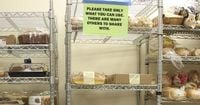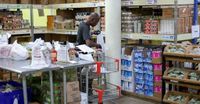Nearly 42 million Americans are facing the prospect of empty dinner tables and uncertain futures as the ongoing federal government shutdown threatens to halt Supplemental Nutrition Assistance Program (SNAP) benefits nationwide. In Arizona alone, nearly 900,000 individuals—spread across more than 450,000 households—depend on these monthly food stamps, which average about $358 per household and total over $161 million in benefits, according to recent state figures cited by Capitol Media Services. The potential loss of this lifeline is sending shockwaves through communities, food banks, and state governments from coast to coast.
"We're going to really count on our nonprofit social service community to step up and be partners," Arizona Governor Katie Hobbs said on October 24, 2025, underscoring the dire situation. She made it clear that the state cannot backfill the loss if SNAP funding dries up next week. "Arizona doesn't have the capacity to backfill that," Hobbs explained, referencing the limited and strictly earmarked funds at her disposal. Earlier this month, she allocated $13.5 million for eviction prevention and homelessness response, but those dollars come with usage restrictions, and most federal COVID relief funds are already exhausted.
While Arizona is bracing for the worst, other states are scrambling to soften the blow. Virginia Governor Glenn Youngkin declared a state of emergency, allowing for the use of emergency funds to support residents. Colorado Governor Jared Polis requested $10 million from lawmakers to sustain food stamp assistance. In New Hampshire, officials are working with food banks to set up 20 new mobile food pantries. Louisiana Governor Jeff Landry also declared a state of emergency, pledging to prioritize food security for vulnerable groups, though specifics remain unclear. California Governor Gavin Newsom announced he would deploy the National Guard to help support food banks, a move reminiscent of the COVID-19 pandemic response.
The crisis, however, is not confined to state budgets and emergency declarations. At the federal level, the U.S. Department of Agriculture (USDA), which administers SNAP, has warned that funding will run out on November 1, 2025. Payments are on hold "until further notice," according to Agriculture Secretary Brooke Rollins. The USDA blames Democrats, stating, "We are approaching an inflection point for Senate Democrats. Continue to hold out for healthcare for illegals or reopen the government so mothers, babies, and the most vulnerable among us can receive timely WIC and SNAP allotments," as reported by NPR. (It's important to note that undocumented immigrants are not eligible for the Affordable Care Act.)
Democratic lawmakers, meanwhile, are urging the USDA to tap into its $5 billion contingency reserve to keep SNAP afloat during the shutdown. Arizona Attorney General Kris Mayes echoed this call in an October 24 letter to Secretary Rollins, noting that Congress appropriated at least $6 billion in reserve funds specifically for such emergencies. The Center for American Progress and the Center on Budget and Policy Priorities both argue that the USDA is "legally obligated to release these funds," since SNAP is an entitlement program. Yet, as of this writing, the agency has not responded to these demands or clarified its legal obligations.
For millions, the clock is ticking. Shari Jablonowski, a 66-year-old widow living outside Pittsburgh, is among those bracing for impact. She relies on $291 in monthly food aid for her disabled nephew. "I am very concerned I will not have heat," Jablonowski told NPR, explaining that she has already had to choose between paying utility bills and her car payment. The looming loss of SNAP benefits would also ruin Thanksgiving for her family—a sentiment shared by many across the country.
SNAP, formerly known as food stamps, is the nation's largest anti-hunger program. Joel Berg, CEO of Hunger Free America, told NPR, "If the SNAP program shuts down, we will have the most mass hunger suffering we've had in America since the Great Depression." The vast majority of recipients are children, working adults, older Americans, veterans, and people with disabilities. For many, SNAP is the only direct financial assistance they receive, as cash welfare was dramatically reduced in the 1990s and Medicaid payments go straight to healthcare providers.
But SNAP isn't the only program at risk. The Special Supplemental Nutrition Program for Women, Infants, and Children (WIC), which serves 7 million women and children, is also on the brink of running out of funds. While the previous administration used $300 million in tariff funds to keep WIC afloat, those reserves are expected to be depleted within weeks. Some states have pledged to fill the gap, but not all have the resources to do so.
Meanwhile, food banks are already feeling the strain. Jerry Brown, spokesman for St. Mary's Food Bank in Arizona, reported, "We've seen 10% increases four years in a row." Last year alone, there were 2.4 million visits to the organization's locations, resulting in the distribution of 129 million pounds of food. "That's before any of this other stuff," Brown noted. On October 24, he described lines "out the door and snaking down Thomas Road," with food boxes containing fewer items due to increased demand. "We never said 'no' to anybody, and we're not going to," he added, but admitted that resources are stretched thin. The hope is that the shutdown ends before the traditional Thanksgiving rush.
States and cities are also urging residents to prepare. The Arkansas Department of Human Services advised those with October SNAP benefits still on their cards to stock up on shelf-stable foods. Across the country, the U.S. Conference of Mayors sent a letter to the USDA emphasizing that SNAP helps stabilize local economies, with $8 billion in benefits distributed monthly to over 250,000 food retailers.
To add insult to injury, new work requirements for SNAP recipients—passed by Congressional Republicans earlier this year—are set to take effect on November 1, the same day benefits might end. These requirements are expected to push 2.4 million people off the program over the next decade, even as millions more face immediate hunger if the shutdown persists.
For those like Jablonowski, the only option is to stretch what little they have. She plans to increase visits to food pantries and is already making big batches of soup to freeze for later. "There's nothing I can do to make money," she said. "I'm not in the greatest of health." Her story is echoed in food bank lines and kitchen tables across the nation.
As the shutdown drags on, the blame game in Washington continues, with both parties pointing fingers over the failure to pass a continuing resolution and disagreements about Affordable Care Act subsidies. Governor Hobbs, for her part, called the situation "infuriating," urging federal leaders to stop "playing political games" and focus on solutions. But as the days tick by and contingency funds remain untapped, millions of Americans are left wondering how they'll put food on the table next month. The stakes, as advocates warn, have not been this high since the Great Depression.


